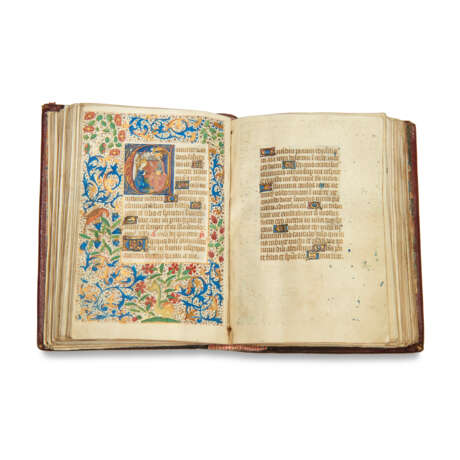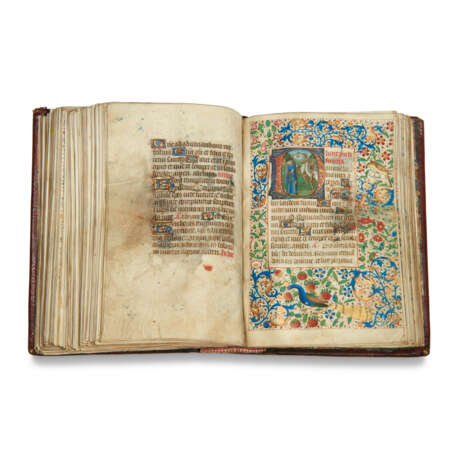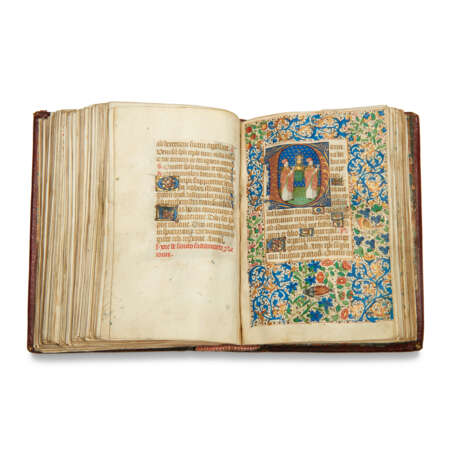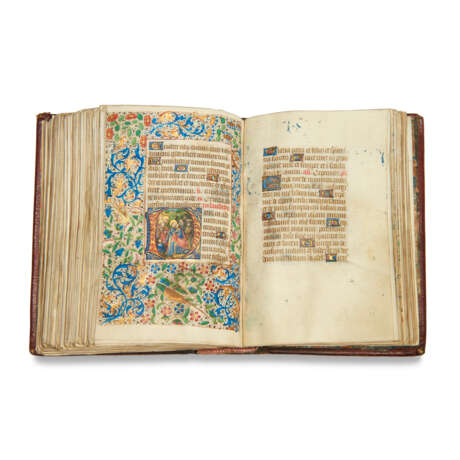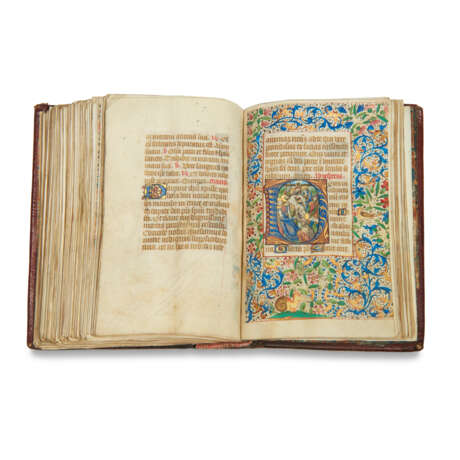ID 1249793
Lot 35 | Master of the Rouen Échevinage (active 1460s-80s)
Valeur estimée
£ 12 000 – 18 000
Book of Hours, use of Paris, in Latin and French, illuminated manuscript on vellum [Paris or Rouen, c.1470s]
A pocket-sized Hours containing an exceptionally dynamic and emotionally powerful cycle of miniatures illustrating the Hours of the Passion and Offices of the Week by the Master of the Rouen Échevinage.
132 x 93mm. ii + 206 + i leaves, 16 lines, ruled space: 66 x 45mm, rubrics in red, illuminated initials throughout, 8 miniatures within full floral borders (lacking 21 leaves, of which likely 19 with miniatures after ff.12, 22, 40, 49, 60, 62, 74, 97, 134, 141, 144, 147, 150, 153, 158, 167, 174 and 182 – see Content below – some marginal cropping, some offsetting, ff.131-137 dampstained, the miniatures themselves in good condition). 17th-century calf, tooled in gilt (edges a little scuffed).
Provenance:
(1) Although the liturgical use is of Paris, the Calendar is decidedly Rouen, with the Translation of St Ouen on 5 May, St Romain on 17 June, and the Translation of St Evodius on 8 July. There is evidence of early French ownership, with additions to the Calendar for Feasts relating to the Virgin.
(2) Armorial bookplate with three crowns arrange 2 and 1 and a duck, surmounted by the motto 'Virtus non sola Corronat [sic]' on inside upper cover.
Content: Calendar ff.1-12v; Gospel extracts ff.13-16 (lacking opening); Obsecro te and O intemerata ff.16-22v; Hours of the Virgin, use of Paris, ff.23-72v: matins f.23 (lacking opening), lauds f.41 (lacking opening), prime f.50 (lacking opening), terce f.54, sext f.57v, none f.61 (lacking opening), vespers f.63 (lacking opening), compline f.68v, with rubric at end indicating ‘hore defunctorum pro die lune’ but following with the Seven Penitential Psalms and Litany ff.73-97v (lacking opening); Office of the Dead, use of Paris, ff.98-134v (lacking opening); Sunday Office of the Trinity ff.135-136v (lacking opening); Monday Office of the Dead ff.137-141v; Tuesday Office of All Saints ff.142-143v (lacking opening); Wednesday Office of the Holy Spirit ff.144-146v (lacking opening); Thursday Office of the Holy Sacrament ff.147-147v; Friday Office of the Cross ff.148-150v (lacking opening); Saturday Office of the Virgin ff.151-153v (lacking opening); Hours of the Trinity ff.154-158 (lacking opening); Hours of the Passion ff.159-184v: matins f.159 (lacking opening), lauds f.163v, terce f.168 (lacking prime and opening of terce), sext f.171v, none f.175 (lacking opening), vespers f.179, compline f.183 (lacking opening); the Passion according to John ff.185-186v; prayers to be said during confession and communion ff.186v-190v; prayers to the Trinity and the Virgin ff.190v-192; Suffrages (to Sts Augustine, Mary Magdalene, Anne and Katherine) ff.192-194; 7 verses of St Bernard ff.194-195; Suffrages to Sts Julian, Maturin, Michael, Gabriel, Raphael, angels and archangels ff.195v-199; Credo and prayers in French, added in a near-contemporary hand, ff.199v-206.
Illumination:
The present manuscript boasts an exceptional cycle of dynamic and emotionally engaging historiated initials for the Hours of the Passion and the Offices of the Week in the best hand of the Master of the Rouen Échevinage (also known as the Master of the Geneva Latini), named for the splendid secular manuscripts he painted for the public library assembled by the aldermen of Rouen. His career, which began c.1460 and spanned about three decades, made him the dominant illuminator in Rouen, at a time of burgeoning book production in manuscript and then print. His colourful and accessible style, with its clearly delineated forms, was comparatively easy to imitate and he seems to have worked with assistants and collaborators to meet the great demand for his work in Normandy and beyond. Unlike many of his larger-format productions, though, we see in the smaller, more intimate compositions in the present manuscript the full extent of the Master's engaging style and consummate skill. For the Master and his work, see F. Avril and N. Reynaud, Les Manuscrits à Peintures en France 1440-1520, pp.169, 171-173.
The subjects of the miniatures are as follows: Annunciation to the Shepherds f.54, the Adoration of the Magi f.57v, the Coronation of the Virgin f.68v, Dance of Death f.137, the Procession of the Eucharist f.147, Betrayal of Christ f.163v, Christ carrying the Cross f.171v, the Deposition f.179.
Christie's is grateful to Gregory Clark for his thoughts on this manuscript.
| Lieu d'origine: | Europe de l'Ouest, France, Europe |
|---|---|
| Catégorie maison de vente aux enchères: | Manuscrits médiévaux et de la Renaissance, Livres et manuscrits |
| Lieu d'origine: | Europe de l'Ouest, France, Europe |
|---|---|
| Catégorie maison de vente aux enchères: | Manuscrits médiévaux et de la Renaissance, Livres et manuscrits |
| Adresse de l'enchère |
CHRISTIE'S 8 King Street, St. James's SW1Y 6QT London Royaume-Uni | |
|---|---|---|
| Aperçu |
| |
| Téléphone | +44 (0)20 7839 9060 | |
| Commission | see on Website | |
| Conditions d'utilisation | Conditions d'utilisation |
